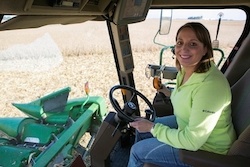 User of Trimble Connected Farm solution can now view task data and as-applied maps transferred wirelessly from from Raven’s Slingshot system. Using the Slingshot API, Connected Farm is able to communicate with Raven systems like the Viper Pro or Viper 4. Wireless access allows for transferring of field data and locating equipment in the field.
User of Trimble Connected Farm solution can now view task data and as-applied maps transferred wirelessly from from Raven’s Slingshot system. Using the Slingshot API, Connected Farm is able to communicate with Raven systems like the Viper Pro or Viper 4. Wireless access allows for transferring of field data and locating equipment in the field.
With this integration users who subscribe to Raven’s Slingshot system will be able to automatically transfer data from their Slingshot Web accounts and Raven’s field computers into Trimble’s Connected Farm.
“Farmers should have a choice in the brands and solutions they use in their operation,” said Joe Denniston, vice president of Trimble’s Agriculture Division. “Pulling data from multiple sources and delivering it in a manner that allows for timely decision making is critical for managing costs. With this integration, growers can now access all of their Trimble and Raven data from one central location in Connected Farm to enable improved decisions from the office and the field.”
“Raven believes that our customers’ data and equipment should work with the software and management tools they already use. We believe in fitting into the unique way our customers manage their business rather than dictating how they run their business. Integration with Connected Farm is another example of this,” said Josh Skanderup, product manager for Raven Slingshot.












